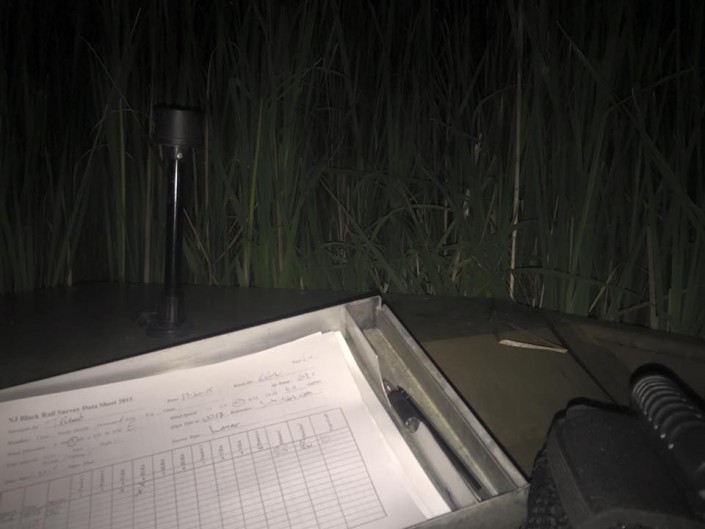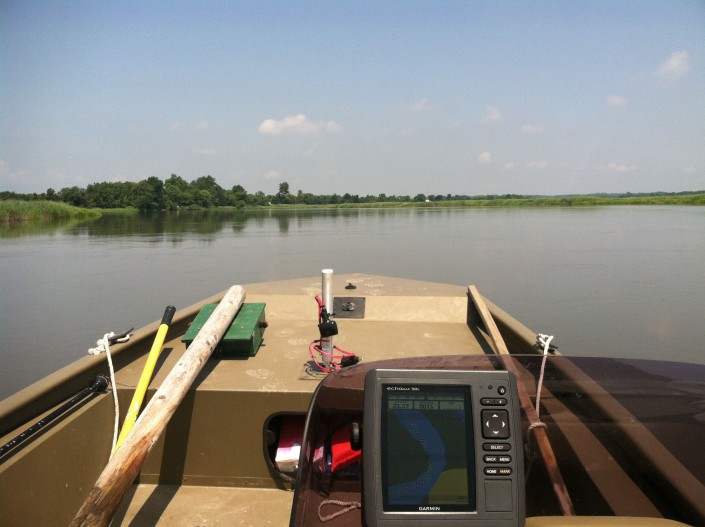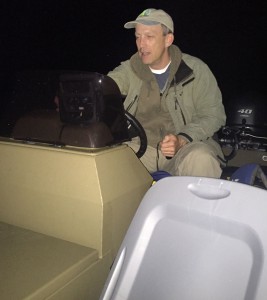Black Rails: Secretive Denizens of our Coastal Marshes
Searching for a Small, Dark Bird at Night, in the Dark
By: Alfred Breed, Field Technician

Shhhhhhhh. Be very, very quiet. Sit perfectly still. Listen. When you are searching at night in the dark for the black rail, the rarest and MOST secretive of the secretive marsh birds, your best sense to use for detection is hearing.
The black rail is a small, darkly-colored marsh bird whose numbers are believed to have declined precipitously in the past few decades, primarily due to habitat loss (when their preferred high marsh habitat was filled and developed), as well as sea-level rise and the loss of salt hay farms (in New Jersey). The breeding population is likely extirpated from both Connecticut and New York, while its continued stability here in New Jersey is in question. Its conservation status varies by state, with full protection as an endangered species in New Jersey and some other states, and only the cursory protection of the Migratory Bird Treaty Act of 1918 in other, mostly southern states. Even in states where they are not listed as threatened or endangered, black rails are rarely seen because of low abundance, their secretive habits, and the inaccessibility of their preferred habitat.
Because of both its rarity and extremely secretive nature, the detailed habits of black rails are little known. Furthermore, historic and current population numbers critical to establishing its conservation status are not well understood. It is thought that they mostly feed during daylight hours, quietly traversing the marsh mud in search of seeds and invertebrate prey, thus remaining largely undetected beneath the dense grass mat. But during the breeding season they call, quite loudly, to each other at night.
This habit, nocturnal vocalization, is what we hope to use to determine the continued presence of black rail here in our coastal marshes, and eventually their abundance and other critical biological information. As part of a cooperative effort by the Conserve Wildlife Foundation of New Jersey, the New Jersey Division of Fish and Wildlife, and New Jersey Audubon Society, staff and volunteers are conducting surveys at points throughout the black rail’s potential breeding range in New Jersey and other states. One purpose of such research is to collect and analyze data in order to establish sound, effective, science-based species management plans coordinated across the species’ entire range.

The current phase of the black rail project requires me to transport by boat four expert bird-by-ear surveyors, capable of identifying birds common to the coastal marsh habitat from their song alone, at night. I bring each “listener” to ten randomly selected points within suitable high marsh habitat at the proper tide and during the designated survey period between 10:30 PM and 3 AM. Each 10-point survey route is repeated three times across a six-week period from May-July. Surveyors record all of the identifiable species they hear as well as the direction and estimated distance of the calls from each survey point.
The survey consists of two minutes of passive listening followed by several recorded black rail vocalizations broadcast from a very loud speaker that are interspersed with short silences in order to listen for any response. The black rail calls are followed by calls from Virginia and clapper rails, as they will also sometimes elicit a response from our quarry. Surveys are conducted with winds below 12 mph and in little to no precipitation in order for the sound to carry to both human and bird ears. Absolute silence is critical in order not to miss any of the more distant calls that pierce the darkness. The scrape of a boot on the deck, the crinkle of a snack wrapper, or a sudden sneeze has the potential to drown out the sound of a distant call. Discussions about species, direction and distance are held in a quiet whisper.

This season, our four survey routes encompassed appropriate habitat areas of several of the tributaries to the Great Egg Harbor Bay watershed. In our quiet and isolated marsh stream we are joined only by the birds we hear, many fireflies and less benign insects, spring peepers, croaking bullfrogs, and the occasional splash of a startled muskrat. Periodic traffic noise from the roads that encircle Great Egg Harbor Bay are a reminder that it is difficult to entirely escape civilization here in New Jersey. But listening to the marsh at night, while boating up a narrow isolated tributary that snakes its way toward the transition from marsh to upland, definitely allows for a sense of quiet communion with nature. Because of its extensive lighting, the BL England power plant in Beesley’s Point is truly a bejeweled wonder to behold at night from almost anywhere in the watershed, and the light pollution that emanates from the Atlantic City sky line can be actually quite helpful for nighttime navigation.
As far as this season is concerned, all of the hoped for data was successfully collected from each point during the survey periods, with only one survey transect interrupted by an un-forecast pop-up lightning storm that required a quick race back to the safety of the boat ramp. With the surveys now completed, we look forward to sharing the results when they are available for release.
This is the first of hopefully many seasons of data collection of this type. As each season’s final results are collected and analyzed, we hope to focus our survey efforts from geographically random points within appropriate habitat, to the areas of repeated detection, and to eventually be able to achieve our long term goal: namely a science-based understanding of the black rail population in our state that informs a viable and effective species management plan.
As a result of my participation in this study with four expert surveyors, for three survey nights each, at 10 points per night, and 10 minutes per point, I have had the privilege of intently listening for over 20 solid hours to our nighttime native secretive marsh bird songs in the presence of experts who can teach me what it is we’ve heard. Although I was only able to master a few of the calls with which I was not already familiar, it has truly been a pleasure and a valuable learning experience accompanying these experts into the field. I can’t wait to do it again next season!
The Conserve Wildlife Foundation and New Jersey Division of Fish and Wildlife wish to thank Alf for the excellent logistical, navigation, and boat handling skills he brought to this project. Just as we could not conduct the survey without our observer’s expert ears, we would be equally lost without Alf’s expertise on the water. Thank you, Alf!